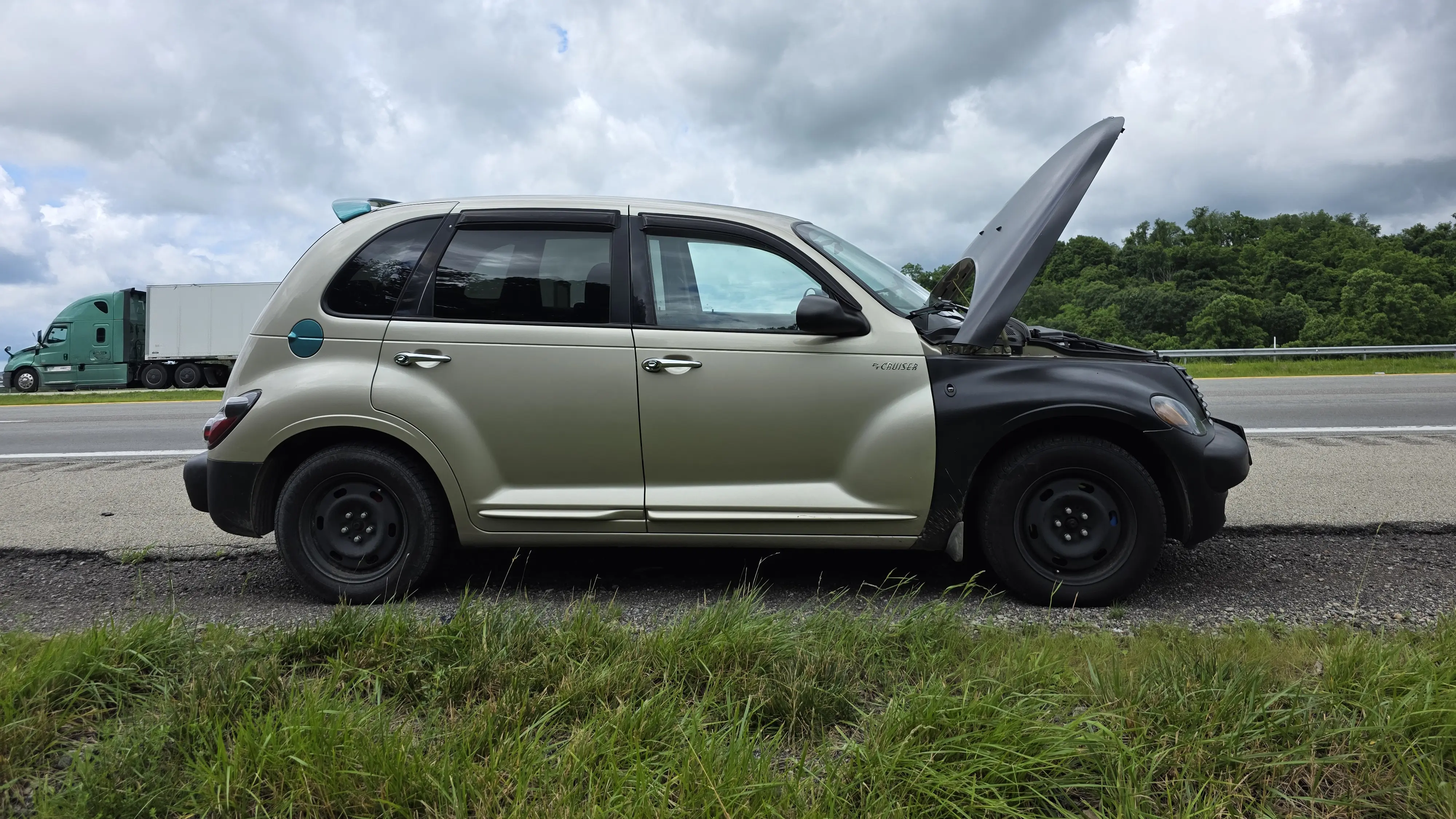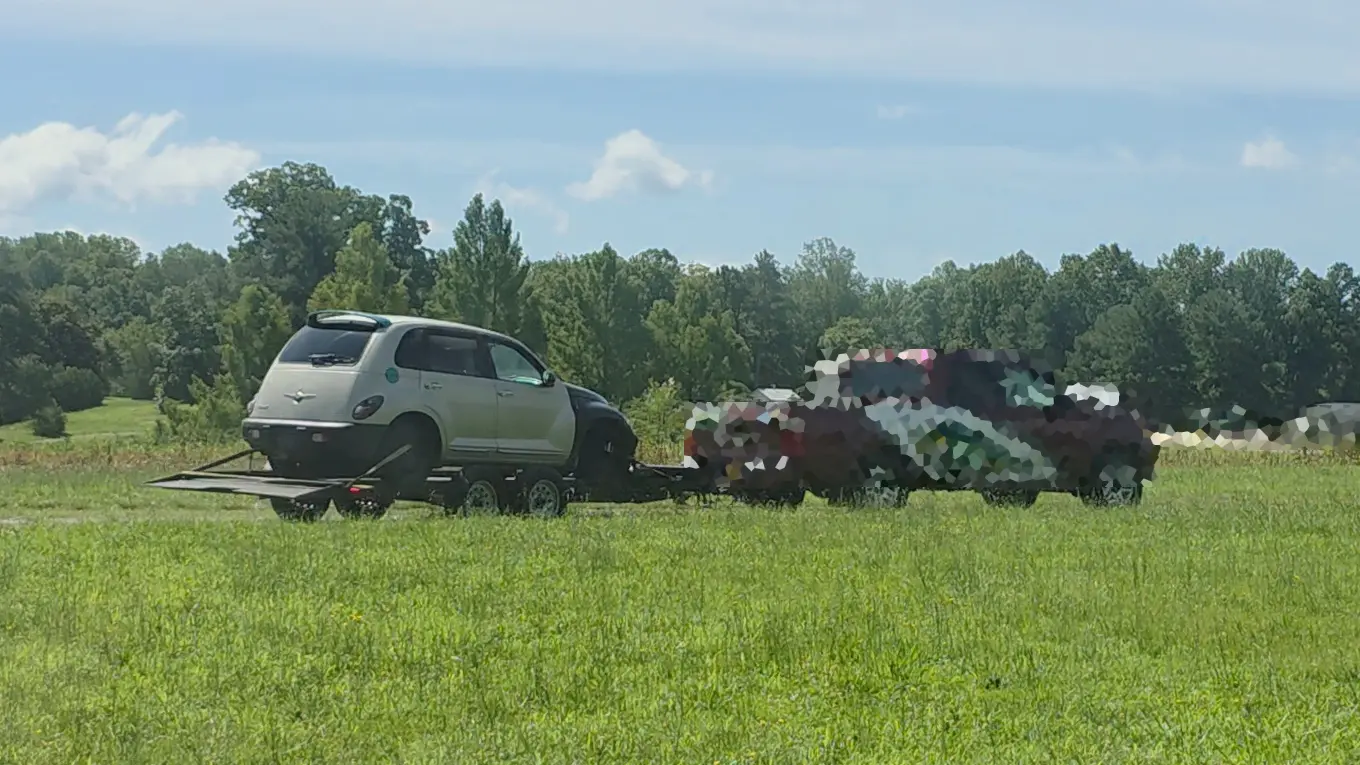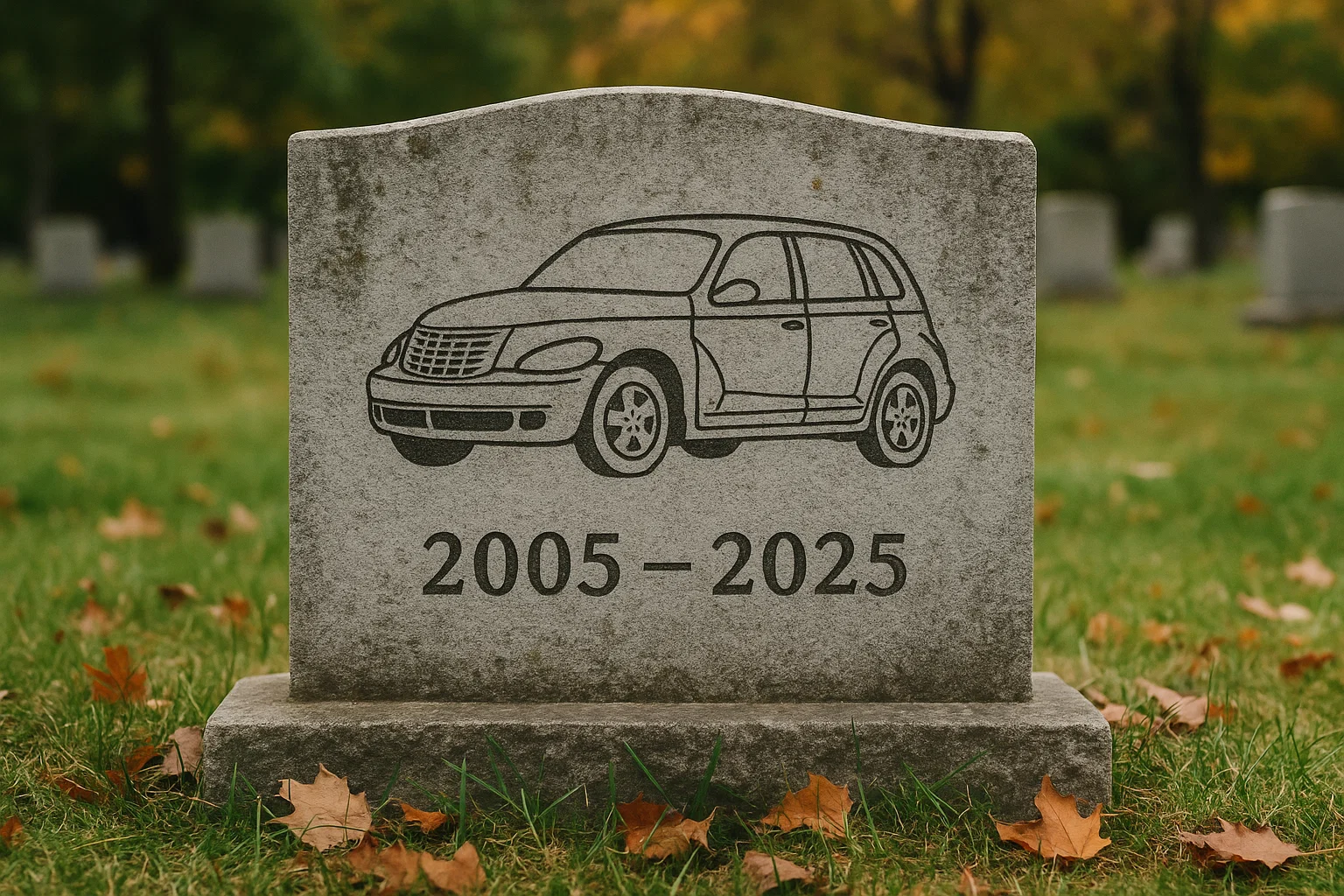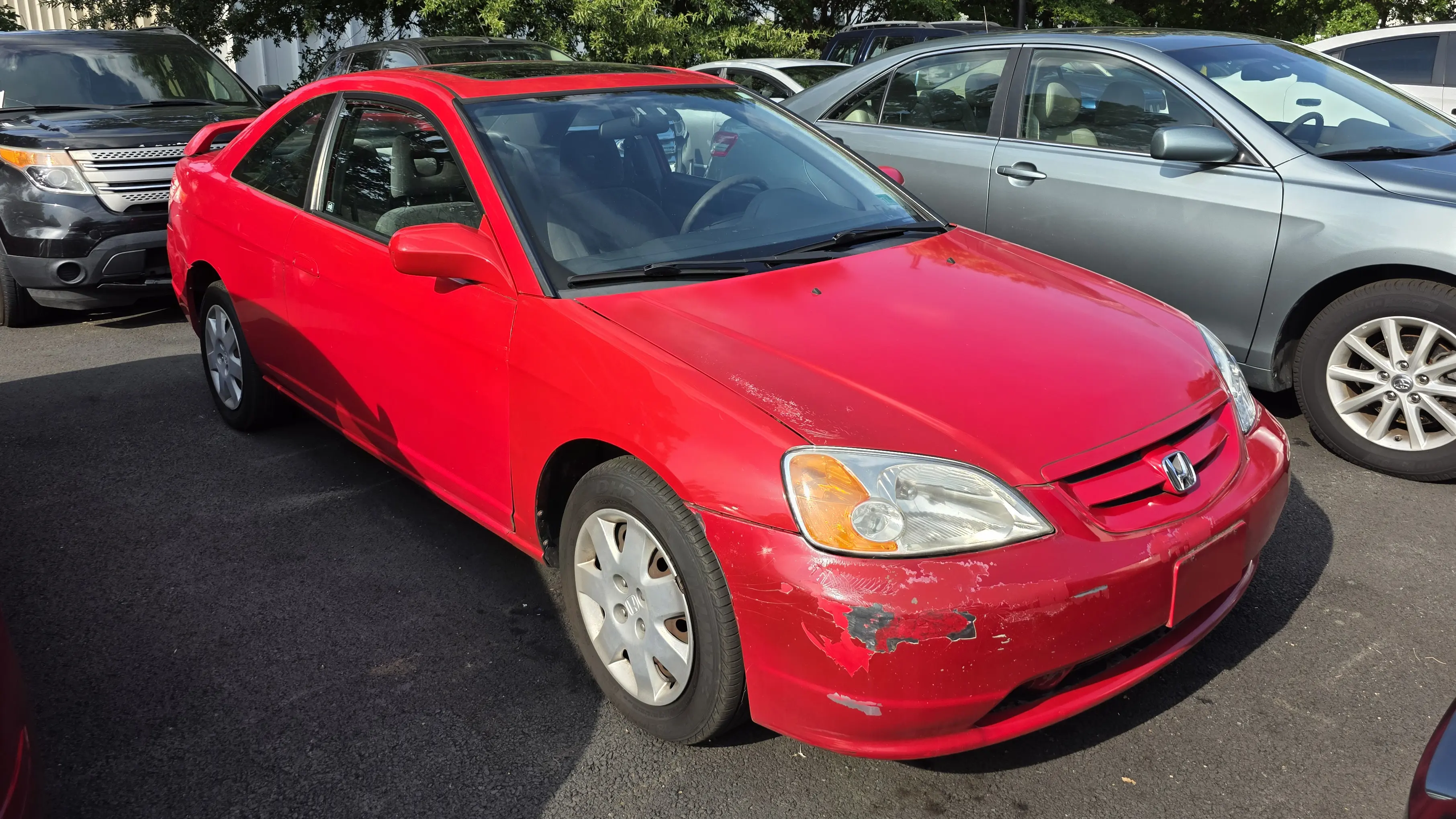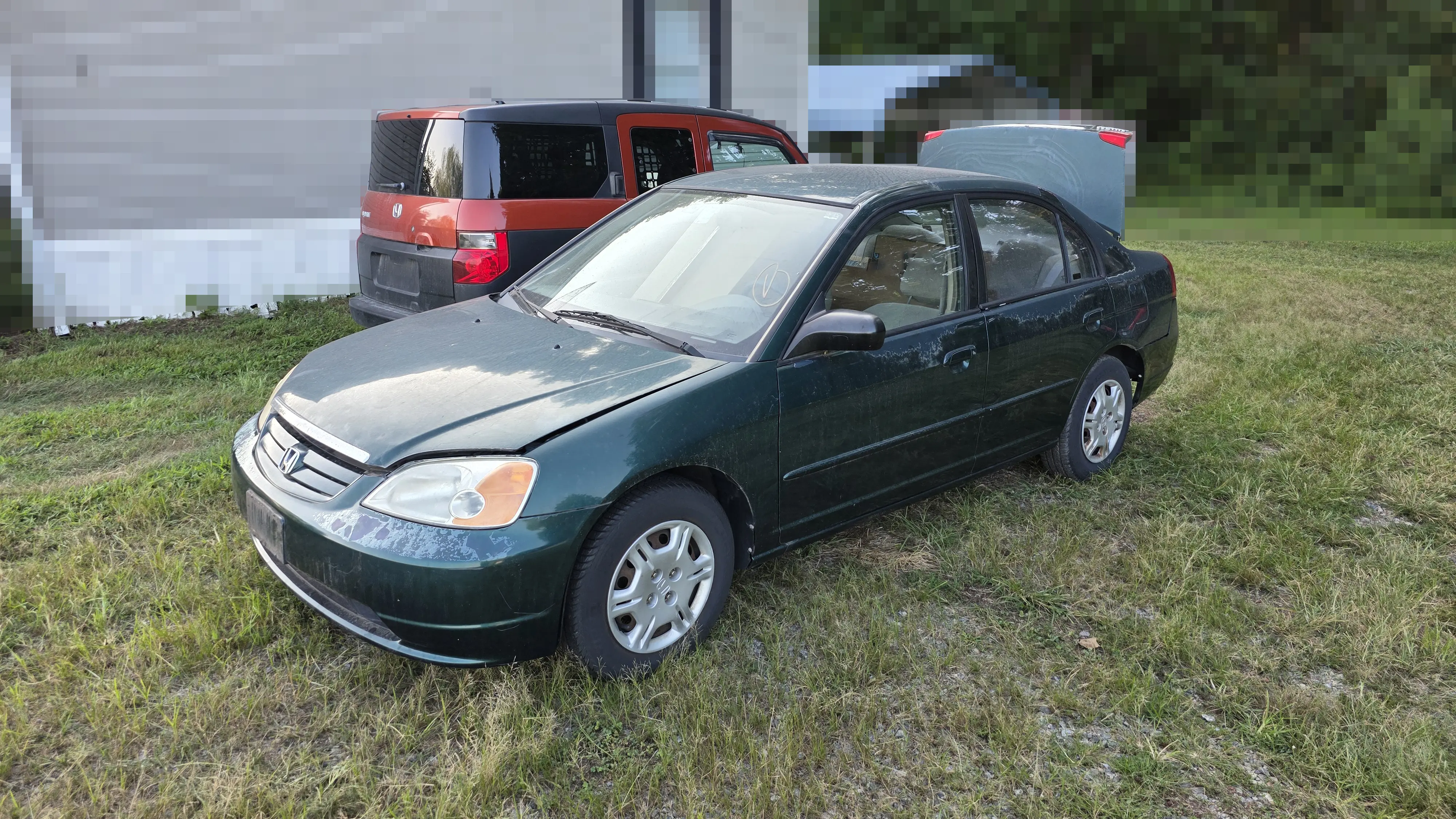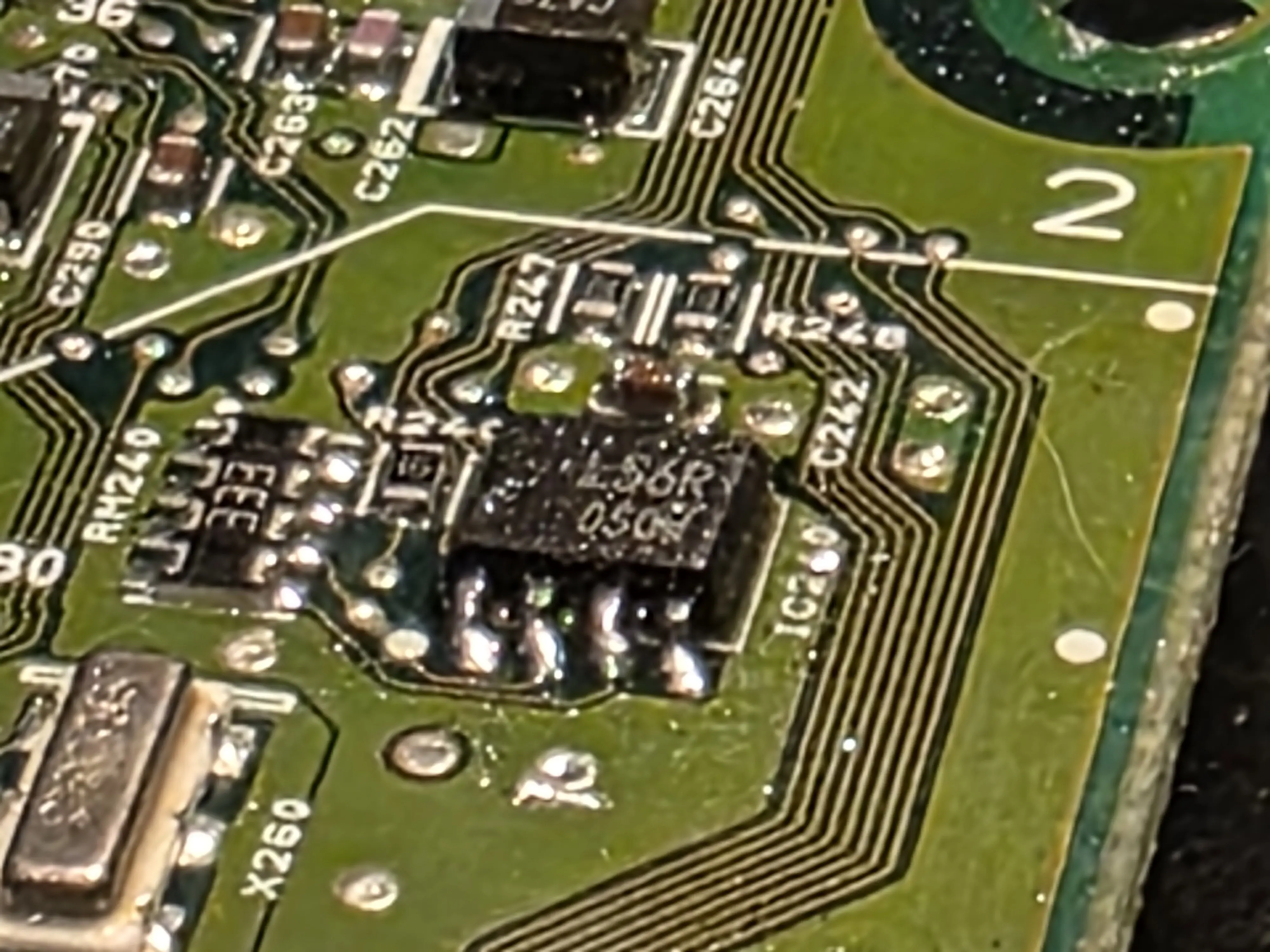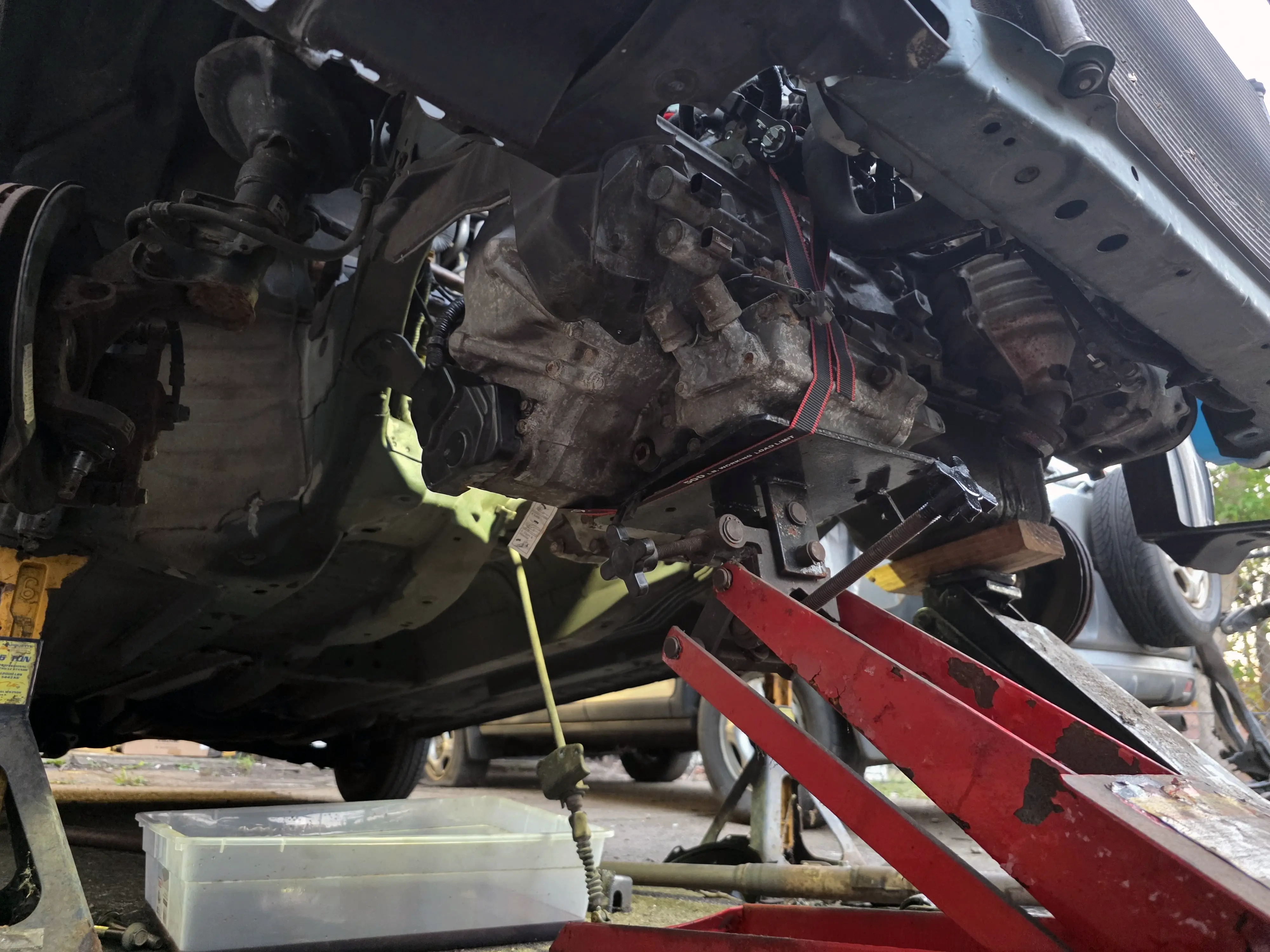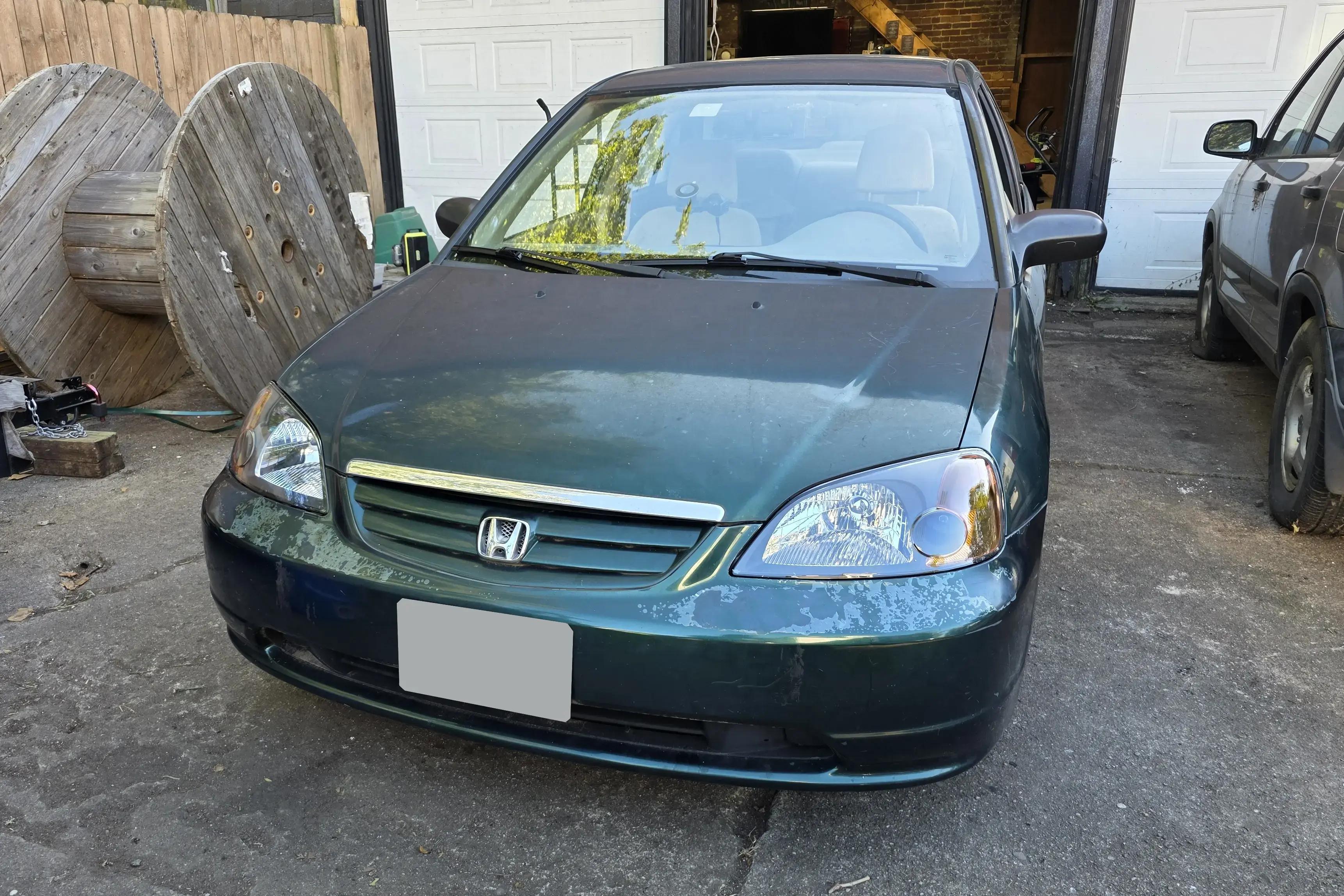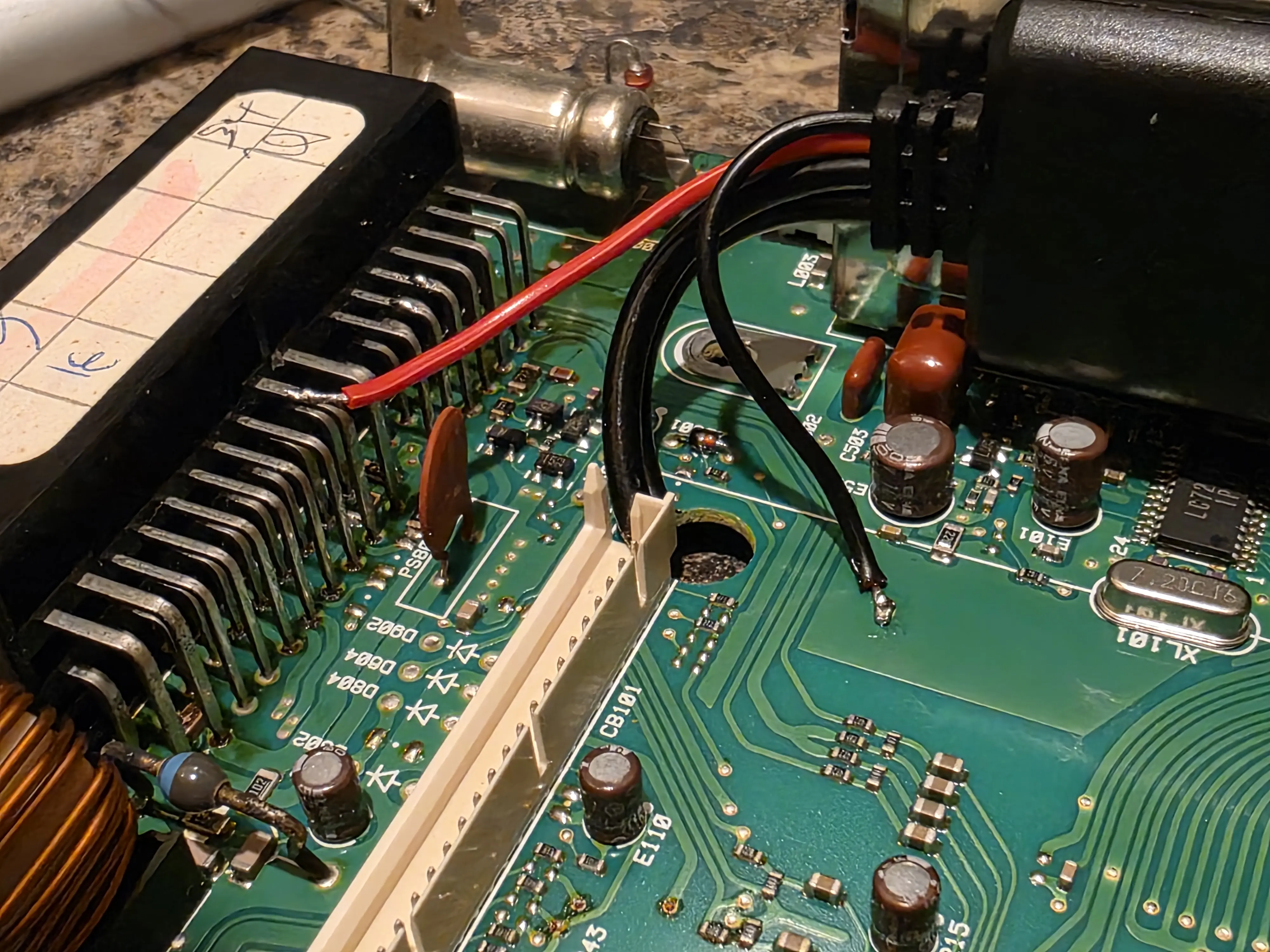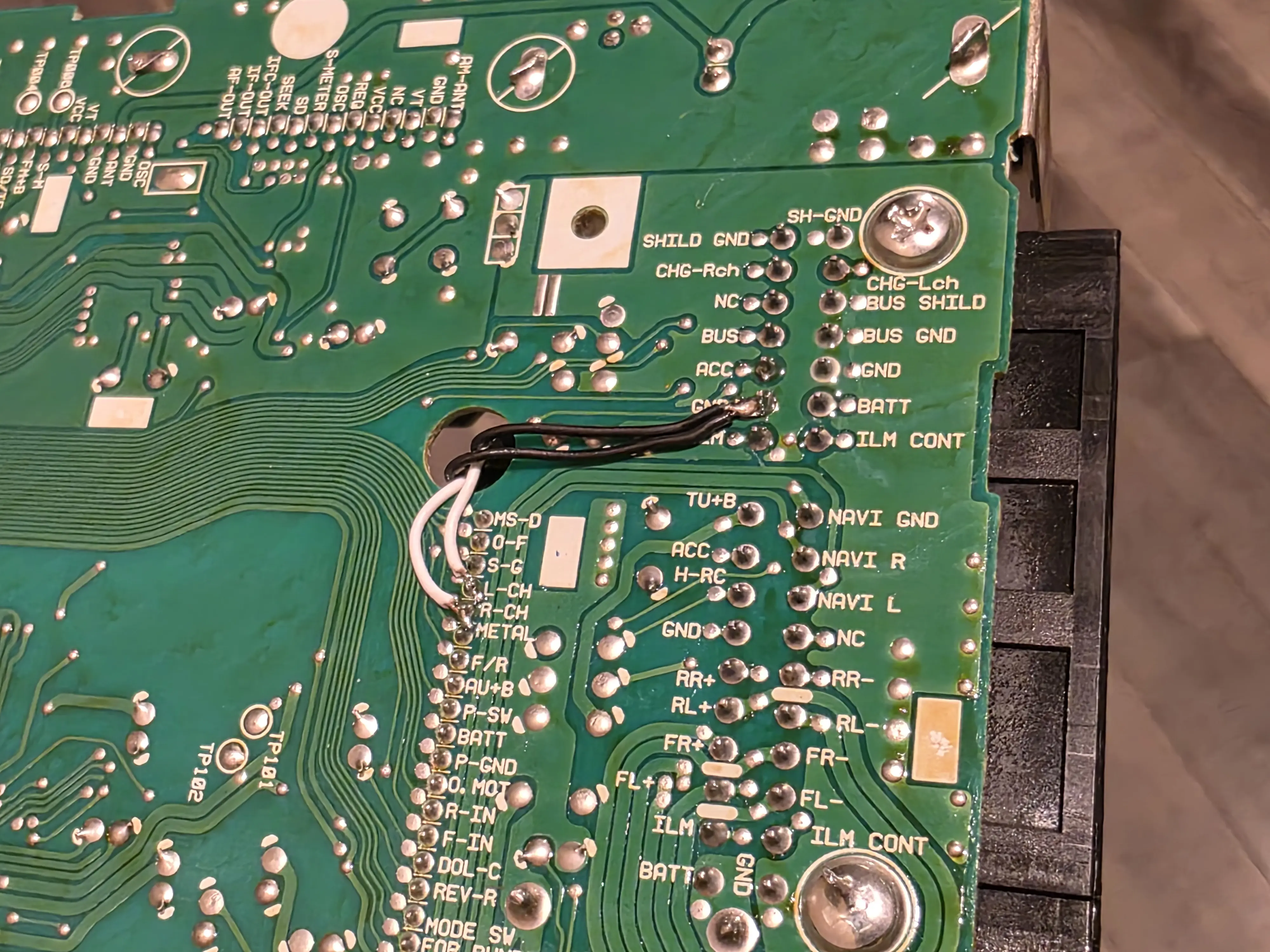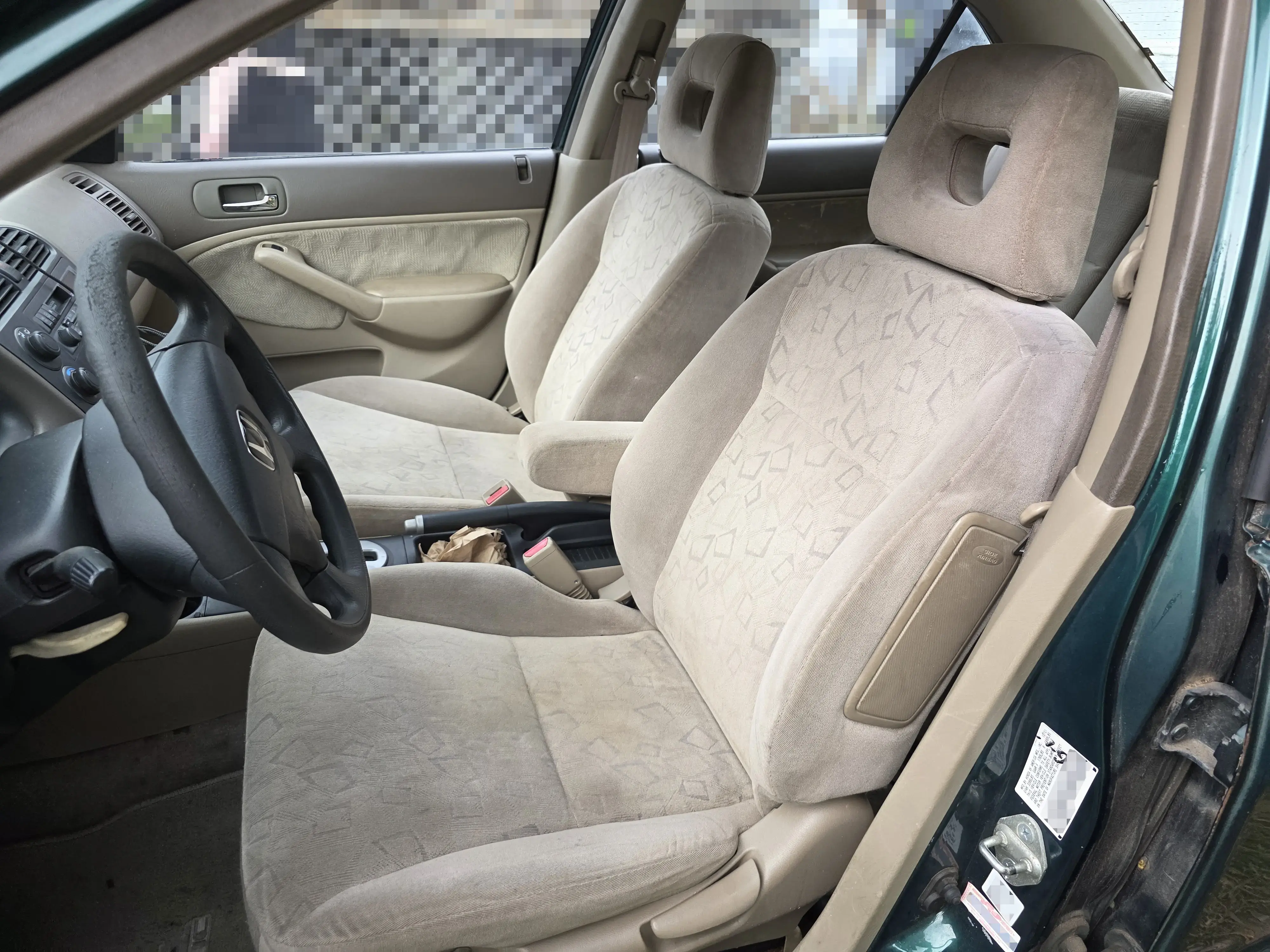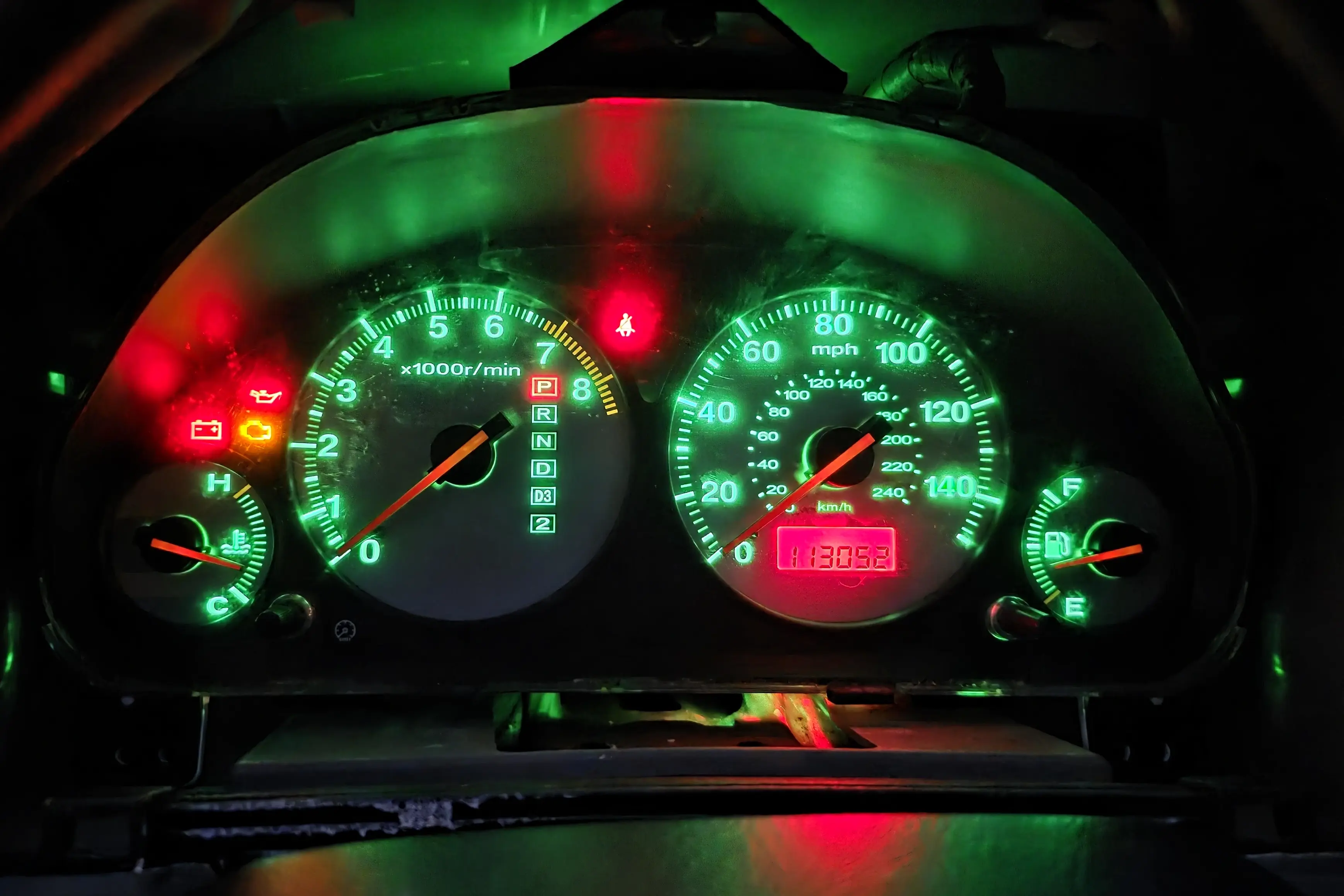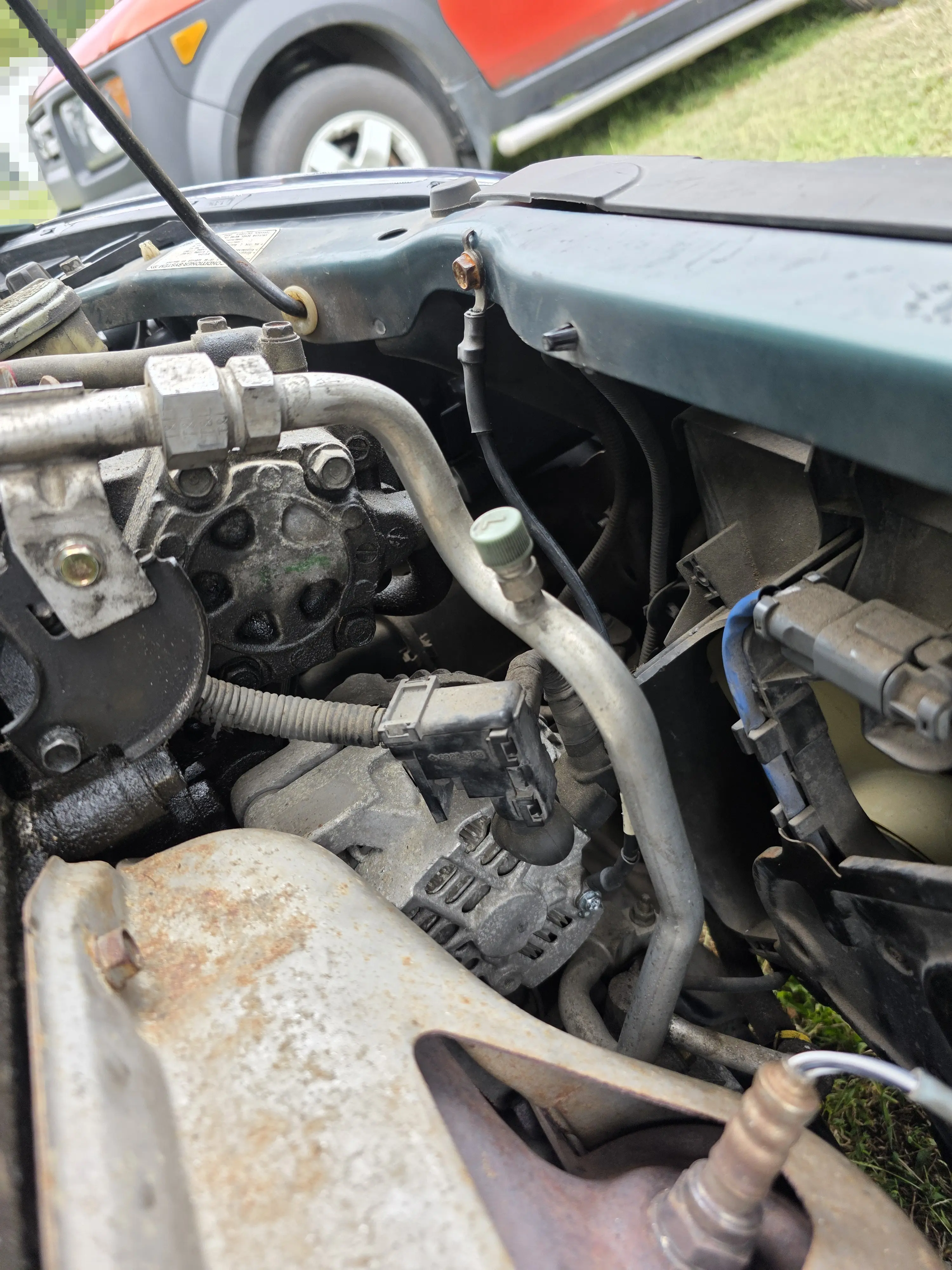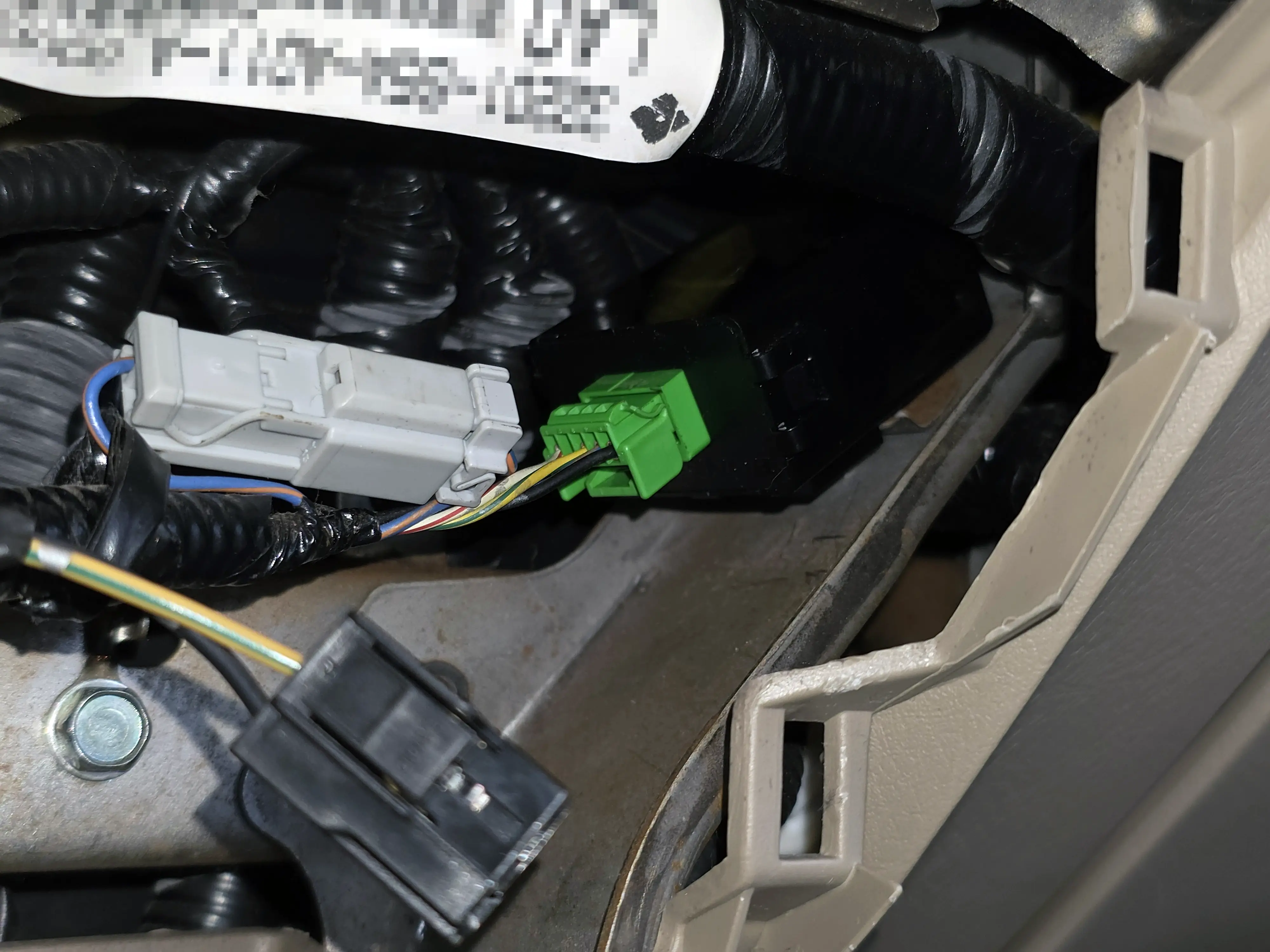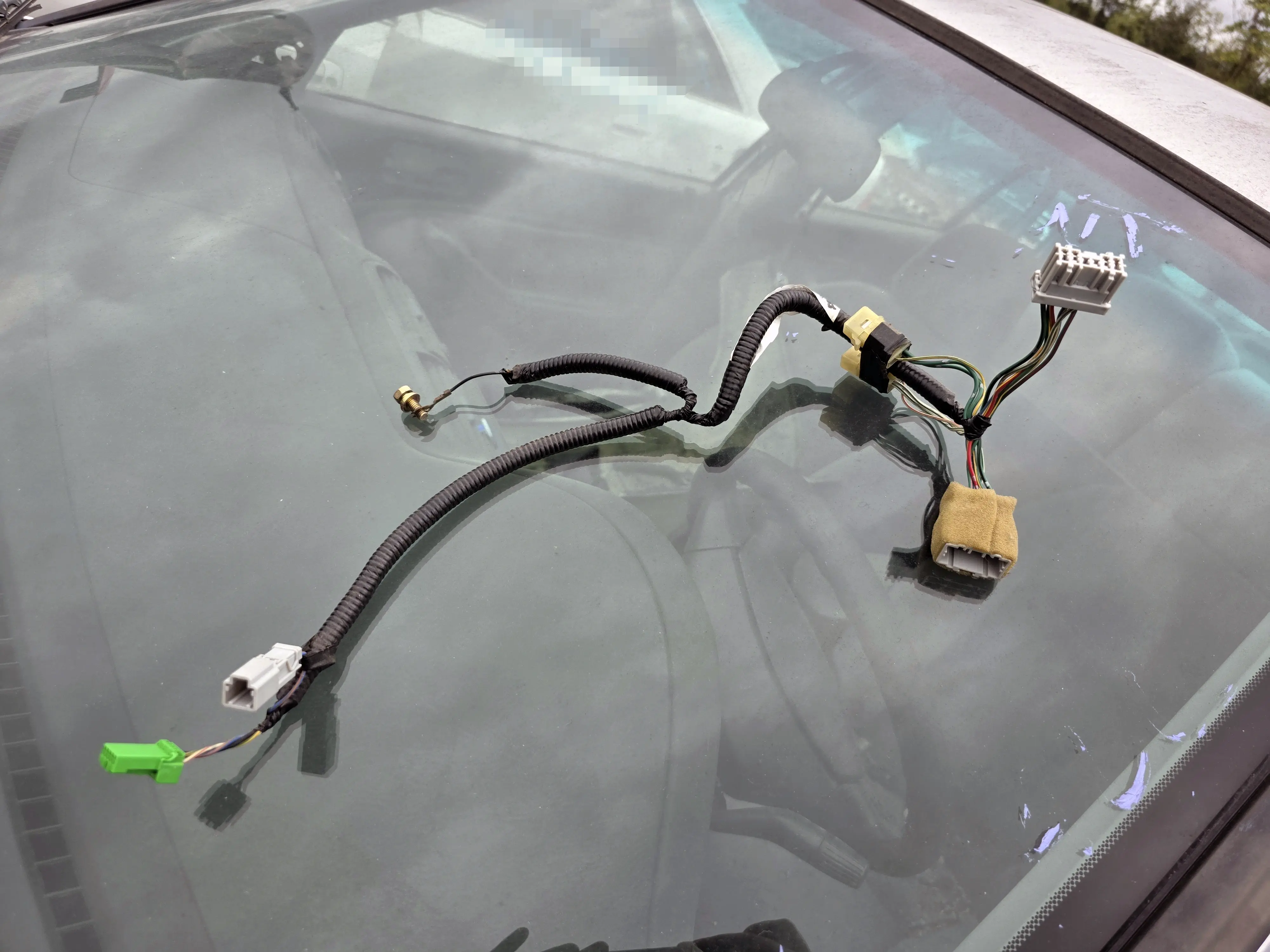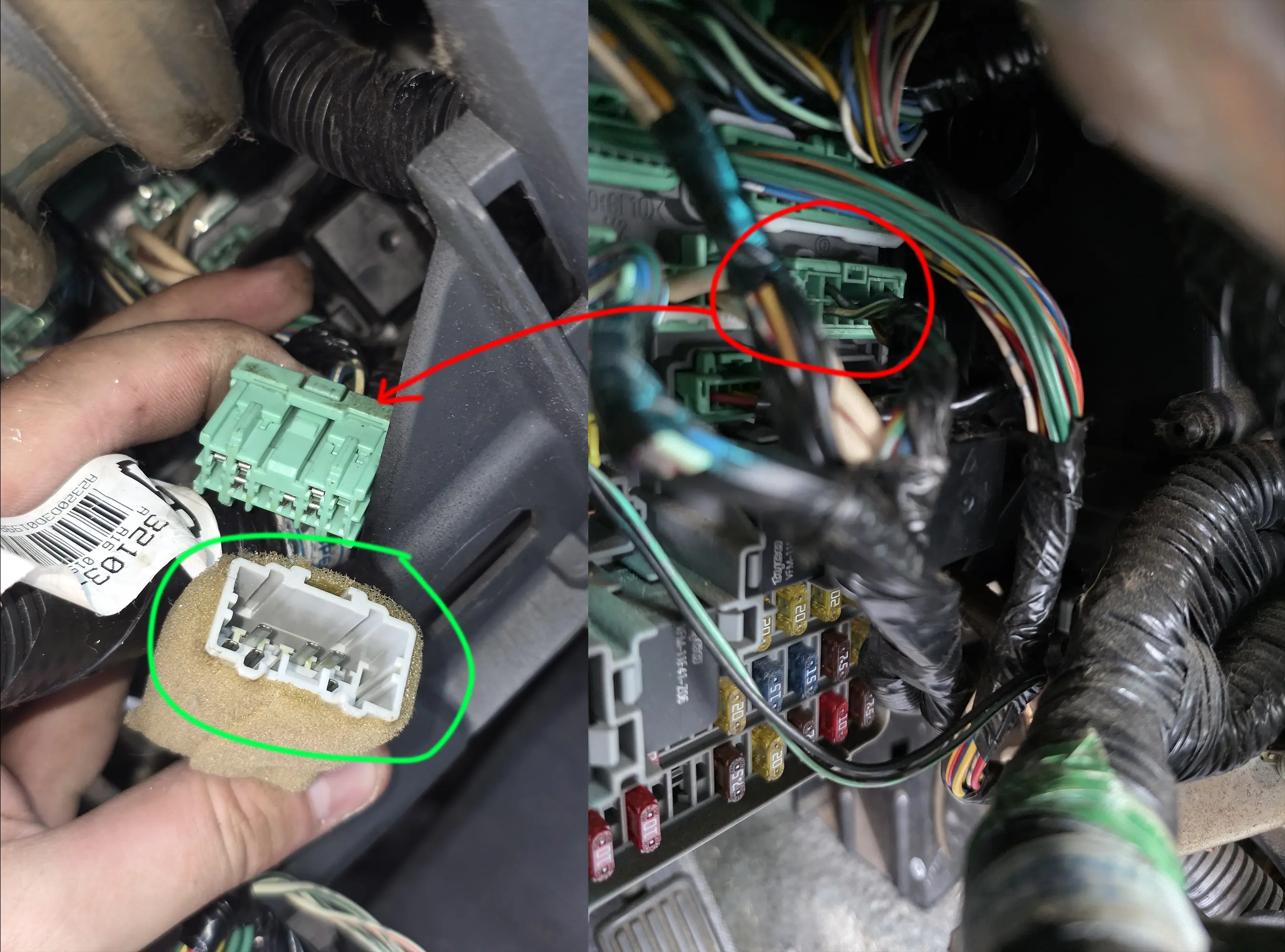Requiem for a Daimler(Chrysler)
Part 1: Sad Summer
In June of 2025, my poor PT Cruiser suffered a string of systemic failures that culminated in the ol' girl kicking the bucket just before hitting 190K.
In one incredibly long weekend I overheated going up a mountain, got stranded for a few hours, got a brief tow, then drove the rest of the way to my destination once the engine cooled down. Two days spent investigating the issue led me and my mechanic (a close relative of mine) to conclude that it was probably fine. We thought the issue was with my cooling fans or thermostat not functioning properly.
I left my mechanic's house at around 08:00 and didn't get home until 21:00. This drive was only supposed to take 8 hours, but the overheating, getting stranded, and eventually getting towed 125 miles closer to home added up to about 13 hours total.
My PT Cruiser was out of commission for about two weeks while I diagnosed, tested, and eventually resolved the overheating problem by replacing the coolant and radiator. I was ecstatic and that car never purred so well and she drove cold as ice for another month or so.
One evening, going about 45 mph on a straight road (downhill even!), the wife and I headed home from the grocery store as the Cruiser just stopped accelerating. No BANG, no grinding, no death knell or warning whatsoever. She slowed to a stop and never drove again.
I called our roommate and he came to the rescue, took us and the groceries back home, and I called a tow truck the next morning. I met the driver on the side of the road (8 miles from my house) and he followed me back to the driveway. He dumped the car, collected the ~$190 I owed him, and I set off to repair the cruiser yet again.
After discussing it with my mechanic and weighing my options, I decided that this old car wasn't worth the effort and money anymore, so I decided to sell the car to the local car yard where I get a lot of spare parts from. To "give 'er back to God" as it were.
Sidenote: I don't believe the car ever made it to the pickyard, I'm fairly certain it just got sold at auction. What a shame.
Part 2: Frustrating Fall
With the cruiser gone, the search began for a replacement as I really appreciate having two cars as my wife still works and when her car is acting up, she can then use one of mine as a spare. (This will be important later.)
I started scouring local used car lots, online ads, CarMax, CarFax, Craigslist, AutoTempest, ebay Motors, and even Facebook marketplace, but none had a vehicle worth purchasing. All were too expensive, too damaged, or too far away. I wasn't 100% set on what kind of car I wanted to get yet; I was mostly looking at 2nd Gen Honda CR-Vs and 7th–8th Gen Honda Civics.
A few different listings stuck out to me, both 7th Gen Civics (2001-2005) and both with a host of issues that became obvious as I saw them in person and finally realized why they were listed for so long and so cheap.
The first was a $4,500 Civic Coupe, bright red, tons of cheap respray and body panel issues. It also threw an engine code for a bad gear ratio which heavily indicates a bad transmission. This was a shame since it only had 120K miles on it. The second was similarly priced, in an ugly tan color, a few dents, but this one actually rand and drove alright. It definitely had an exhaust leak or some kind of aftermarket muffler so it sounded like shit and had cheap, failing tint. I think it only had 160K on the odometer.
I happened to check AutoBidMaster one afternoon and found a green 2002 Civic Sedan with a surprisingly low number of miles (only 112K!). My curiosity was piqued and I placed a measly $500 bid on the car. The auction listed it as a donated car that would start under its own power (or with a jump), would shift into drive, and move forward. I figured that I would gamble on the car and see if it would be my little emerald in the rough. It was also listed as a donated vehicle, so I hoped that meant that it was just neglected and not a turd.
The paint's clearcoat was heavily damaged, the battery was dead, and the engine seemed to have a minor oil leak. Without seeing the car in person, I just had to rely on fate to see if the car would be worth the effort. The auction closing day finally came and I won the auction with a bid of $1,600. This was not what I ended up paying and only started the laundry list of shenanigans that would end up plaguing me because of this too-good-to-be-true car.
The auction closed, but the purchase hadn't been finalized because the seller had to "approve" my bid. This shady practice is known on AutoBidMaster as an "on approval" auction as opposed to a "pure sale" auction where the final price is whatever the last person bid before the close of the auction. The seller ended up contacting me a few hours later stating that I could win the auction if I increased my bid to $2,000. This was just plain insulting and really goes against the whole point of auctions. I couldn't complain too much since I knew this was a possibility before I bid, but I figured that even $2,000 was worth it if I could secure such a low-mileage Civic.
I declined the offer for $2,000 and retorted with $1,800. He countered with $1,950 and didn't respond to any counters from me. I eventually caved and agreed to the $1,950 and began the purchase process. The purchase price was bad enough, but the $1,200 in fees from AutoBidMaster was really painful to swallow. The site also charged me ~$300 to ship the car from their lot to my house which was only a distance of about 30 miles.
I paid the company the ~$3,500 it ended up costing and a few days later the green meanie was in my driveway and the real torment could finally begin.
Part 3: Civic Duty
The tow truck dropped it off in my roommate's parking spot, so my first order of business was to move the damn thing. This was difficult with a dead battery (which was really dead and wouldn't hold a charge), so I instead opted to lube up the cylinders with some fogging oil through the spark plug holes—as it had been sitting for some time—then attempt to start it with my old Honda Element group 51R battery. It fired right up after much protesting from the stale fuel and slumbering electrical system. I put it in drive, pulled it about 20 feet down the driveway, and parked it. There it would sit for another two weeks.
During all this time, my wife and I started to pack our things and prepare to move from my roommate's house and into a new place on the other side of town. This put a damper on my car repair time which started interfering with my pack-n-move time, all to the chagrin of my dear wife.
Between moving preparations and going to work, my time was limited to get the Civic into good enough shape to make the 30 mile trip to the new house. I had a list of things to do:
- Change the oil
- I already had the correct oil and filters as I have a similar year Element
- Replace the thermostat
- Just in case
- Drain and fill the coolant
- I didn't have any Honda Type 2 so I used Zerex Asian Vehicle antifreeze
- Change the transmission fluid
- Put some new gas in it
- Check the tire pressure
- All 4 wheels matched and had good tread, which was nice
Once all that was done, I took her on a maiden voyage to the gas station. This is when I noticed the shifting issues. The tranny shifted really hard, a lot harder than it should, even though it was a 20+ year old car. I thought it might be me not putting the right level of fluid in it, but I triple checked it and the fluid level was fine. This was bad news bears indeed.
My mechanic wasn't 100% convinced the tranny was bad as it was throwing some codes for a bad PCM (computer) and some bad shift solenoids. I started on the latter, buying two off of ebay, installed them both, and while those codes went away, the shifting was as bad as ever.
Moving day came and went with the Civic holding its section of the driveway firm. I hadn't driven it far enough to be sure that it could make the 30 mile trip to the new place. After everything else had been moved, the Civic was all that remained. I needed to replace the PCM before it could be moved though. There is apparently a design flaw with this generation of Civic where if the alternator gets loose, it can ground out on the interior of the engine bay and fry the computer. I believe this is what happened to mine. I purchased a replacement PCM on ebay for $45, removed the two immobilizer chips from my old one and soldered them onto the new one. This took about an hour and completely resolved the engine codes for the PCM.
My wife and I drove down one night and she dropped me off at the (now) old house. She went to see a relative and I went to work replacing the PCM and checking the ATF again and when I determined that the levels were good. I took it for a very short spin and the shifting hadn't gotten better at all. After a few minutes, I decided to just start driving and see how far I could get.
I started off down the road and after a few minutes of it banging around, I threw it in 2nd gear and drove the whole trip at ~35 mph. This annoyed the hell out of the folks behind me on the single-lane roadways that I had to drive down, but I had my hazards on, so oh well.
I parked it in the driveway, locked the doors (with the key, no keyless entry), and there it sat.
Part 4: Drive-by-Night
A week goes by and my mechanic (who lives a few hundred miles away) said that he had an open weekend, a used tranny for the Civic lined up, and all the tools to do the swap at his house. He just wanted me to be sure that it was the right move since he had to rely on my amateur observations and my lacking vocabulary and therefore couldn't make a very informed judgement call.
I took it to a chain mechanic that was open during the evening and they confirmed that the tranny was bad and needed a rebuild if not a full replacement. I relayed that to my mechanic and he purchased the tranny. Now it was the end of the week and with my slim window of opportunity approaching, I decided to make the eight-hour drive to his house—with the Civic's transmission shifting harder than ever—and hope for the best.
I left the new place at 23:30 as I was too riled up about the upcoming trip to sleep after getting home from work at 17:00. I think I only got three hours of sleep that evening.
The first hour went well. Since it was the dead of night, traffic was light and I wasn't as likely to get in anyone's way while making the trip. I drove the majority of the trip in Drive, but some areas were limited to 2nd as the tranny didn't like low speeds.
The next few hours were pretty calm, but I was getting very tired as the night wore on and the dawn approached. A few close calls with dozing off, a weird sound I heard in traffic (that turned out to be my fender liner scraping against my tire, I later cut it off at a gas station), and a clunky-ass-drivetrain were the biggest worries from the trip. By 08:00 on Saturday, I was in the driveway of my mechanic's house. I then proceeded to go upstairs and crash for six hours in his spare bedroom.
The afternoon rolled around and as I got out of bed, I see the Civic in his backyard now and he confirms that the tranny is bad (and worse than he expected!) and that he can definitely replace it with me over the next two days. We got to work, raised the car on jack stands, removed the undercarriage, dropped the old tranny, and popped in the new one by 22:00 that night.
Sunday morning, we put the subframe back on, replaced the headlights (I brought them with me), cleaned up the mess, and went to the store to get some ATF and cotter pins. We filled the fluid, felt the gears, and took it for a successful test drive. We celebrated with a big dinner that he and his wife cooked up. I went to bed around midnight and left for home at 09:00 the next morning, but with pockets about $460 lighter after the tranny and ATF.
The drive back was a lot easier than the drive down. Although, ten minutes into the trip the engine threw a P0740 Torque Converter Clutch Solenoid Circuit error. The transmission still shifted just fine, so I drove the few hundred miles back home, stopping for gas, and to fix the fender liner issue that one time.
I pulled into the driveway and breathed a sigh of relief, but work on the Civic had only just begun.
Part 5: Updates and Upgrades
I started to draw up a list of all of the parts of the Civic that I wanted to repair, replace, or otherwise modify:
- The radio was the cassette variant and had no Bluetooth
- The cheap tint was failing and bubbling
- The speakers were broken in the front and sounded like crap in the back
- The seats were uncomfortable and had no back support
- There is a minor oil leak around the cam plug and valve cover grommets
- The instrument cluster lights are dim
- The alternator wasn't properly grounded
- There is no keyless entry
- The front passenger door does not unlock with the rest of the doors
Part 5-1: Radio
My first thought was to simply add Bluetooth to the existing stock radio. This would add some modern functionality while retaining the stock design. I accomplished this by purchasing a universal Bluetooth module for about $8, stripping the RCA connectors off, and wiring it up to the tape deck circuitry inside the radio.
This worked, but the deck was smart enough to not output sound from the tape circuitry without a tape present. I popped in a dummy tape and that sort of solved the issue, but the whole-time music is playing I can hear that tape spinning. The audio quality wasn't amazing and it was rather quiet, but it worked for a short while. I ended up going back to using one of those Bluetooth FM transmitter devices instead.
A few days later, I found a silver Civic radio from a Hybrid 2003, cleaned it up, and popped it in the dash. It looks good and sounds good too.
Part 5-2: Tint
The whole Civic was covered in shitty tint that has long gone bubbly and brittle. I spent a few hours scraping it off with a razor blade, but I found out that—at least for the rear window—I could vacuum it off with a strong enough shop vac. This helped me get the rear window about 80% clear before I stopped for the night. I still have some of the other windows to do.
Part 5-3: Sound System
With the radio situation solved, my attention turned to the speakers in both front doors as well as the two under the rear window. I swapped all four with a set of KENWOOD KFC-1666S 6.5" speakers that took some creativity to install since aftermarket speaker brackets for the 7th Gen Civic seem to not exist for some reason. I eventually got them all screwed (or zip-tied in the rear) in and connected to the system using some adapters.
With the doors and rear reassembled, I was able to test out the new sound system and it was leaps and bounds above the old paper drivers that came with the car.
Part 5-4: Seating
After my many-hour drive to get the transmission swapped, I found the stock seats to have very little back support in particular and to be rather uncomfortable in general. This led me to search for some replacements that wouldn't break the bank (or my back).
I did some cursory searching online for some drop-in replacements but I couldn't really find anything appealing. When I took my next trip to the car pickyard however, I found just what I was looking for; A set of tan, 2001 Civic coupe seats with that fun '90s-esque square pattern, and relatively clean upholstery. The yard charged $100 for the pair and I soon had a complete 2nd set of seats.
As an aside, the yard charges like $100 per airbag and these seats both had side airbags. I removed the airbags, placed them inside of the seat beneath the fabric, and snuck them clean out of the yard. They charge $50 for a complete seat and I wanted my money's worth. There is also a small issue of rust on these seats, however. The metal frames beneath them are quite rusty and I am holding onto the old seats so I can swap the metal frames between them someday.
I spent an afternoon cleaning the seats with a small furniture wet-vac and once they were clean and dry, I installed them into the Civic. They look nice and they are much more comfortable.
Part 5-5: Oil Leaks
The small pool of oil on the top of the engine, just beneath the valve cover seemed to be due to a leaky cam plug (my mechanic pointed that out). I spent like $11 and bought a new OEM plug, pulled the old one out, scraped off the RTV that the previous owner thought was necessary, and placed the new plug in place. This seems to have resolved that particular leak.
There are some grommets around the valve cover bolts that seem to be leaking oil as well, but I don't want to replace the grommets until I change the valve cover gasket, which I don't want to do until I change the timing belt, which I don't want to do at all.
Part 5-6: Instrument Cluster Lights
In all my cars, I like to have the instrument cluster lights to be colored in some fashion, usually to match the car. For instance, my 2003 SOP (Sunset Orange Pearl) Element has orange cluster lights to match the paint color. The Civic is no different. I considered a Christmas-like theme for it as the car is green and I wanted to put some red carpet in it (maybe soon?), but in the meantime, I figured the lights would be easier.
In my cluster, all the lights were the little T5 bulbs that are available in LED form as drop-in replacements. I bought these red ones for like $7. It takes some trial and error to swap them all as the incandescent OEM bulbs don't care what direction they are installed in, but the LED ones only work in one orientation. So you need to swap a bunch around to get them all working after installation.
I actually ended up using green for the dials and red for the indicator lamps and other spots. This accomplished the Christmas look without making it harsh in dim lighting or ugly to look at in general.
Part 5-7: Alternator Grounding Cable
Earlier I said, "There is apparently a design flaw with this generation of Civic where if the alternator gets loose, it can ground out on the interior of the engine bay and fry the computer.", and while I resolved the PCM issue, I want to prevent this from happening in the future. On one of my trips to the car pickyard, I picked up a small grounding cable from some other Honda and figured I'd fashion it to the alternator and ground it to the chassis.
The alternator has a small bolt hole that is unoccupied on the bottom and there was some easy to reach metal nearby. I wire brushed off some of the paint, bolted the cable to the frame, and bolted the other end to the alternator. I checked continuity with a multimeter, and called the job done.
Part 5-8: Keyless Entry
One of the many convenience features that is mandatory on new cars is keyless entry (the ability to (un)lock the doors with a remote instead of a key). This Civic is 23 years old and of a lower trimline, so it doesn't have this feature from the factory. Through many trips to the car pickyard and through some research, I discovered that keyless entry was an option on some similar year models, the hard part was finding one at the pickyard!
I was able to find some Civics with keyless entry, but these all had a different wiring harness from what my Civic had. The plug needed for the keyless entry module was just not present on mine. After failing to find one that fit my car without modification, I decided to wire one up myself. I took another trip to the pickyard and figured I'd get some of the wires and connectors that I need so I can create my own harness. Luckily, I discovered a single 2002 Civic in the lot with keyless entry AND my style of wire harness.
This was strange and I hand't seen that setup on the dozens of other Civics that I had looked at previously. Upon closer examination, I found a supplementary harness that adapts the '02 Civic's wiring to support a keyless entry module. I grabbed the harness (pictured above), spent ~$50 on a keyless entry module and matching fob from ebay, and snapped it all together. This was all plug-and-play and my old Civic just learned a new trick.
To install this harness in your Civic, start in the fuse panel in the cabin under the steering wheel:
- Unplug the green connector marked with a lower case "g" in the top right corner (red circle in above image).
- Connect it to the white female connector on the keyless entry harness (green circle in above image).
- Plug in the white male connector from the harness into the green "g" connector socket on the fuse panel.
- Route the rest of the harness into the area where the keyless entry module connects to the car.
- This is behind where the 12v socket is, beneat the radio.
- Connect the module to the car (if you haven't already).
- The module clips to a small metal tab on the right side.
- Connect the green plug to the keyless entry module.
- Connect the grey plug to the grey connector with the single wire coming out of it (it may be taped to the rest of the wire harness).
- Connect the ground screw to any available, bare metal location.
- There is a dedicated spot for this screw, but I don't have a picture of the location. If you removed this harness yourself, then you'll know where that goes.
- Done! Test your new keyless entry system.
The cable's part number is: 32201-S5A-A01
The module's part number is: 38385-S9A-A01
I performed this install without disconnecting the battery of the vehicle. You probably should disconnect the battery before doing this though. I also would not recommend buying just the module, try to find one with a paired fob as well. I'm unaware of any method of pairing a new fob (if all are missing) without going to a dealer. If you have at least one good fob, you can pair up to four I believe. I added some to the one that came with my Element. I'll provide the pairing sequence for that below. I haven't tested this on my Civic, just my Element, but here it is:
Programming Replacement Keyfobs
- Ensure all keyfobs that you plan to use with this vehicle are present (max 4).
- These steps are very time-sensitive and must be completed no more than four (4) seconds apart.
- Close door, lock, and unlock doors with button on the door.
- Insert key, turn to II position, press Lock on the keyfob, turn to 0 position
- Try to use a working keyfob and use the same fob for each step until instructed to change it.
- Repeat Step 2 a total of three times.
- Door locks should automatically lock and unlock, indicating that the programming mode has been activated.
- If the door locks don't cycle, start over from Step 1.
- Once the doors stop cycling, press the Lock button.
- Repeat Step 5 for all desired remotes.
- Turn key to 0, remove from ignition.
- Test remotes.
- Further Reading: Element Owners Club
Part 5-9: Passenger Door Lock Mechanism
I haven't addressed this issue yet since it is so minor. Basically, the power lock functionality is not working on the front passenger door. It is probably due to a faulty lock actuator thingy or maybe it just isn't connected right (it does make a sound when you click the lock button). The door still opens, shuts, and locks fine with a key, so I'm not worried about this for the meantime.
Part 6: Daily driving and Closing Remarks
As of writing this section, my wife's car has been at the dealer "getting repaired" for over 30 days now. I didn't get to drive the Civic much after getting it mostly fixed up as she has been borrowing it for commuting to work. I did finally get the dealer to replace the airbags however, but the AC, peeling clearcoat, and new wheels I bought for it have yet to be addressed.
I have an appointment this afternoon to get some new tires mounted on the used wheels I bought and once that is taken care of, I'll mount the assembled wheels on myself. I don't have a picture of the wheels on hand, but they are from a 2003 Civic Hybrid and are the same as those in the above image.
I also put this fun sticker on the back windshield.
I'll start daily driving the Civic after the wife's car gets back from the shop, then I'm sure I'll have some new and exciting mechanical adventures to share with you all. Thanks for reading.

